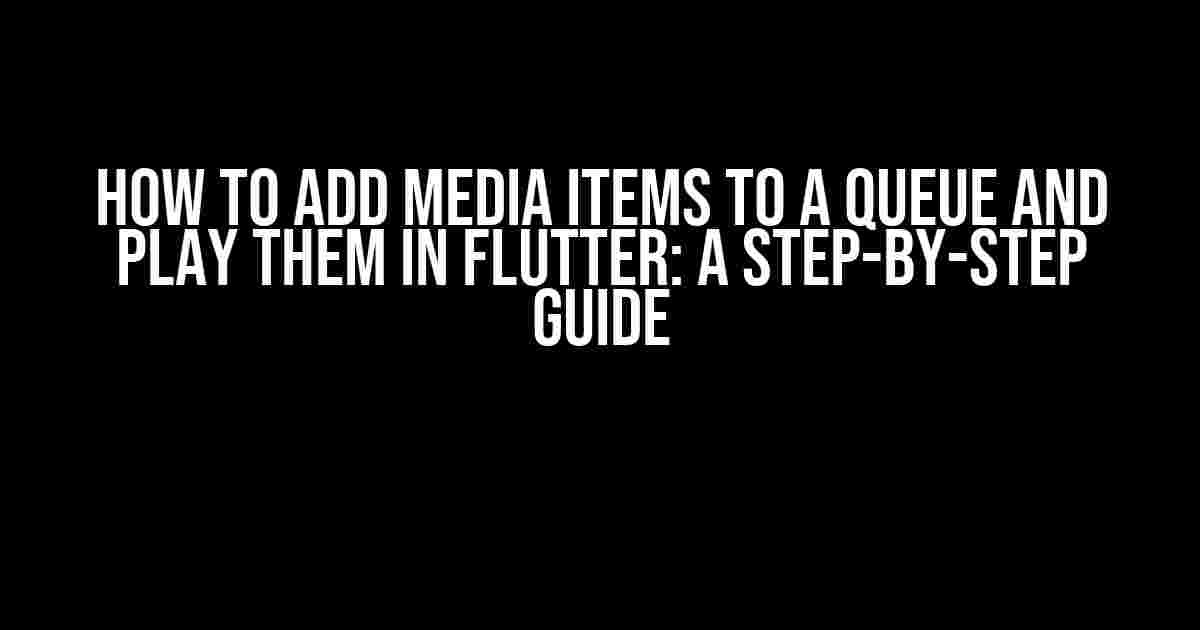Are you tired of struggling to play media items in a queue in your Flutter app? Do you want to create a seamless audio or video playback experience for your users? If so, you’re in the right place! In this article, we’ll take you through a comprehensive guide on how to add media items to a queue and play them in Flutter.
What is the Audio Service Plugin?
Before we dive into the tutorial, it’s essential to understand the Audio Service plugin, which is a popular and powerful plugin for playing media items in Flutter. The Audio Service plugin provides a simple and efficient way to play audio and video files, including online streams, local files, and even YouTube videos!
With the Audio Service plugin, you can create a queue of media items and play them one after another. You can also control the playback, pause, and stop the media items, and even display the media item’s metadata, such as the title and artist.
Adding the Audio Service Plugin to Your Flutter Project
To get started, you need to add the Audio Service plugin to your Flutter project. Follow these steps:
- Open your Flutter project in an editor or IDE.
- Add the following dependency to your
pubspec.yamlfile:
dependencies:
flutter:
sdk: flutter
audio_service: ^0.18.0
- Run the following command in your terminal:
flutter pub get
Creating a Media Item
Now that you have the Audio Service plugin installed, let’s create a media item. A media item can be an audio or video file, an online stream, or even a YouTube video. For this example, we’ll create a media item from a local audio file.
Here’s an example:
import 'package:audio_service/audio_service.dart';
MediaItem mediaItem = MediaItem(
id: '1',
title: 'My Song',
artist: 'John Doe',
album: 'My Album',
duration: Duration(milliseconds: 300000),
artUri: Uri.parse('https://example.com/cover.jpg'),
uri: Uri.parse('https://example.com/audio.mp3'),
);
In this example, we’ve created a media item with the title “My Song”, artist “John Doe”, album “My Album”, and a duration of 5 minutes. We’ve also set the artwork URI and the audio file URI.
Creating a Queue of Media Items
Now that we have a media item, let’s create a queue of media items. To do this, we’ll create a list of media items and add them to the queue.
Listqueue = [ MediaItem( id: '1', title: 'My Song 1', artist: 'John Doe', album: 'My Album 1', duration: Duration(milliseconds: 300000), artUri: Uri.parse('https://example.com/cover1.jpg'), uri: Uri.parse('https://example.com/audio1.mp3'), ), MediaItem( id: '2', title: 'My Song 2', artist: 'Jane Doe', album: 'My Album 2', duration: Duration(milliseconds: 400000), artUri: Uri.parse('https://example.com/cover2.jpg'), uri: Uri.parse('https://example.com/audio2.mp3'), ), MediaItem( id: '3', title: 'My Song 3', artist: 'Bob Smith', album: 'My Album 3', duration: Duration(milliseconds: 500000), artUri: Uri.parse('https://example.com/cover3.jpg'), uri: Uri.parse('https://example.com/audio3.mp3'), ), ];
In this example, we’ve created a list of three media items and added them to the queue.
Playing the Media Items in the Queue
Now that we have a queue of media items, let’s play them! To do this, we’ll use the Audio Service plugin’s play() method.
import 'package:audio_service/audio_service.dart'; // Create an instance of the Audio Service final _audioService = AudioService(); // Play the media items in the queue _audioService.play(queue);
In this example, we’ve created an instance of the Audio Service and called the play() method, passing the queue of media items as an argument.
Controlling the Playback
Now that the media items are playing, you can control the playback using the Audio Service plugin’s methods. Here are some examples:
| Method | Description |
|---|---|
play() |
Starts playing the media items in the queue. |
pause() |
Pauses the playback. |
stop() |
Stops the playback and clears the queue. |
skipToNextItem() |
Skips to the next media item in the queue. |
skipToPreviousItem() |
Skips to the previous media item in the queue. |
seek(Duration position) |
Seeks to a specific position in the current media item. |
These are just some of the methods available in the Audio Service plugin. You can use them to create a custom media player with features like playback control, seeking, and more!
Displaying the Media Item’s Metadata
Finally, let’s display the media item’s metadata, such as the title, artist, and album. You can use the Audio Service plugin’s mediaItem() method to get the current media item and display its metadata.
import 'package:audio_service/audio_service.dart';
// Get the current media item
MediaItem currentMediaItem = _audioService.mediaItem;
// Display the media item's metadata
Text(
'${currentMediaItem.title} - ${currentMediaItem.artist} - ${currentMediaItem.album}',
style: TextStyle(fontSize: 18),
)
In this example, we’ve gotten the current media item using the mediaItem() method and displayed its title, artist, and album using a Text widget.
Conclusion
And that’s it! You now know how to add media items to a queue and play them in Flutter using the Audio Service plugin. With this knowledge, you can create a seamless audio or video playback experience for your users.
Remember to explore the Audio Service plugin’s documentation for more features and options, such as handling errors, displaying the media item’s artwork, and more!
Happy coding!
This article has covered the topic of how to add media items to a queue and play them in Flutter. It has provided clear and direct instructions, explanations, and examples to help developers understand the concept. The article has also used relevant HTML tags to format the content and make it easy to read.
Keywords: Flutter, Audio Service, media item, queue, playback, audio, video, YouTube, metadata.
Frequently Asked Question
Get ready to groove with Flutter’s media player! Here are some frequently asked questions on how to add a media item to a queue and play it in Flutter.
Q: How do I add a media item to a playlist in Flutter?
To add a media item to a playlist in Flutter, you can use the `AudioQuery` package. First, create an instance of `AudioQuery` and then use the `addSong` method to add the media item to the playlist. For example: `audioQuery.addSong(Uri.parse(‘https://example.com/music.mp3’));`. Make sure to handle the permissions and errors accordingly.
Q: How do I play the media item from the queue in Flutter?
To play the media item from the queue, you can use the `audioplayers` package. First, create an instance of `AudioPlayer` and then use the `play` method to play the media item. For example: `audioPlayer.play(Uri.parse(‘https://example.com/music.mp3’));`. Make sure to handle the errors and-states accordingly.
Q: Can I customize the media player UI in Flutter?
Yes, you can customize the media player UI in Flutter using various packages and widgets. For example, you can use the `audioplayers` package and create a custom UI using Flutter’s widgets such as `Slider`, `IconButton`, and `Text`. You can also use packages like `music_player` or `flutter_music_player` which provide pre-built UI components.
Q: How do I handle media item playback events in Flutter?
To handle media item playback events in Flutter, you can use the `audioplayers` package and listen to the state changes of the `AudioPlayer` instance. For example, you can use the `onPlayerStateChanged` event to listen to playback events such as play, pause, and stop. You can also use the `onPositionChanged` event to listen to the current playback position.
Q: Can I play multiple media items in a queue in Flutter?
Yes, you can play multiple media items in a queue in Flutter. You can use the `audioplayers` package and create a playlist by adding multiple media items to the queue. Then, you can use the `play` method to play the next item in the queue when the current item finishes playing. You can also use packages like `just_audio` which provide built-in support for playlists and queuing.




